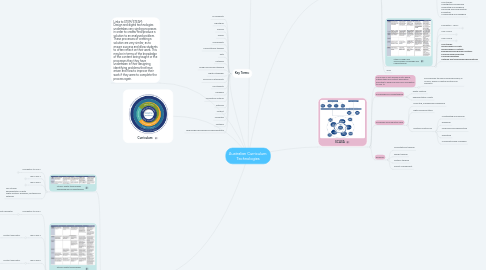
1. Digital Technologies
1.1. Strand: Digital technologies Knowledge and Understanding
1.1.1. Foundation to Year 2
1.1.1.1. Content Descriptor
1.1.1.1.1. Digital systems and their purpose
1.1.1.1.2. Recognise patterns in data- use of symbols
1.1.2. Year 3 and 4
1.1.2.1. Content Descriptor
1.1.2.1.1. Identify digital systems
1.1.2.1.2. different types of data: same can be represented in different ways
1.1.3. Year 5 and 6
1.1.3.1. Content Descriptor
1.1.3.1.1. explain main components of Digital systems
1.1.3.1.2. Whole numbers used to represent data
1.1.4. Sub Strands: Representation of data Digital systems: hardware, software and networks
1.2. Strand: Digital technologies Processes and Production skills
1.2.1. Foundation to Year 2
1.2.1.1. Content Descriptor
1.2.1.1.1. Collect explore and sort data
1.2.1.1.2. Safety of information systems
1.2.1.1.3. sequence of steps
1.2.1.1.4. Create and Organise ideas
1.2.2. Year 3 and 4
1.2.2.1. Content Descriptor
1.2.2.1.1. Define problems and steps to solve them
1.2.2.1.2. implement Digital systems
1.2.2.1.3. Explain student solutions which can meet common needs.
1.2.3. Year 5 and 6
1.2.3.1. Content Descriptor
1.2.3.1.1. Acquire, store and validate different types of data
1.2.3.1.2. Design a user interface for a digital system
1.2.3.1.3. Implement digital solutions
1.2.3.1.4. sustainable and meet current and future local community needs
1.2.4. Sub strands: Collecting managing and analysing data Investigating and Defining Producing and implementing Generating and designing Evaluating Collaborating and managing
1.3. Aims
1.4. Rationale
1.5. Apps to develop skills in this area
1.5.1. Nancy Drew Codes and Clues Mystery Coding Game – My Classroom
1.5.2. Earth 3D app – My Classroom
2. Key Terms:
2.1. Accessability
2.2. Algorithms
2.3. Analyse
2.4. Assess
2.5. Componants
2.6. Computational thinking
2.7. Data
2.8. Database
2.9. Design process and thinking
2.10. Digital citizenship
2.11. Economic sustainability
2.12. Functionality
2.13. Hardware
2.14. Information systems
2.15. materials
2.16. Product
2.17. Properties
2.18. Software
2.19. Technologies processes and specialisations
3. Curriculum:
4. Links to STEM/STEAM: Design and digital technologies undertakes very similar processes in order to create/find/produce a solution to an analysed problem. These processes of creating a solution are very similar, as to ensure success and allow students to often reflect on their work. This may be in terms of the knowledge of the content being taught or the processes they they have undertaken in their designing, identifying problems that have arisen and how to improve their work if they were to complete the process again.
5. Design and Technologies
5.1. Rationale:
5.2. Strand: Design and Technology Processes and Production skills
5.2.1. Foundation - Year 2
5.2.1.1. Content descriptors:
5.2.1.1.1. Needs and opportunities for designing
5.2.1.1.2. Use of Materials and preferences
5.2.1.1.3. Sequence of steps
5.2.2. Year 3 and 4
5.2.2.1. Content Descriptors
5.2.2.1.1. Critique opportunties for designing: explore and test materials
5.2.2.1.2. communicate design with technical terms
5.2.2.1.3. Evaluate design ideas
5.2.2.1.4. Plan a sequence of production steps when making designed solutions individually and collaboratively
5.2.3. Year 5 and 6
5.2.3.1. Content Descriptors
5.2.3.1.1. Investigate materials
5.2.3.1.2. communicate design ideas and processes for audiences with technical terms
5.2.3.1.3. Negotiate criteria for success that include sustainability
5.2.3.1.4. Develop project plans that include consideration of resources when making designed solutions
5.2.4. Sub Strands: Investigating and defining Generating and designing Producing and implementing Evaluating Collaborating and managing
5.3. Strand: Design and Technologies Knowledge and Understanding
5.3.1. Foundation - Year 2
5.3.1.1. Content descriptors
5.3.1.1.1. Design and produce familiar products
5.3.1.1.2. Sustainability
5.3.1.1.3. Create movement in products: Forces
5.3.1.1.4. Characteristics of materials
5.3.2. Year 3 and 4
5.3.2.1. Content Descriptors
5.3.2.1.1. Sustainability
5.3.2.1.2. Fibre production
5.3.3. Year 5 and 6
5.3.3.1. Content Descriptors
5.3.3.1.1. Electrical energy
5.3.3.1.2. Why food and fibre are produced in managed environments and prepared to enable people to grow and be healthy
5.3.4. Sub Strands: Technologies in society Technologies in Contexts Engineering principles and systems. Food and fibre production Food specialisations Materials and technologies specialisations
5.4. Aims
6. SCASA
6.1. Curriculum is not divided up into bands, instead there are content descriptors allocated to each year level from foundation to year 10
6.1.1. Encompasses the same overarching idea, as ACARA, which is creating solutions for problems.
6.2. Knowledge and Understanding
6.2.1. Digital Systems
6.2.2. Representation of data
6.3. Processes and Production skills
6.3.1. Collecting, managing and organising
6.3.2. Digital implamentation
6.3.3. Creating Solutions by
6.3.3.1. Investigating and defining
6.3.3.2. Designing
6.3.3.3. Producing and implementing
6.3.3.4. Evaluating
6.3.3.5. Collaborating and managing
6.4. Requires:
6.4.1. Computational thinking
6.4.2. Design thinking
6.4.3. Systems thinking
6.4.4. Project management
